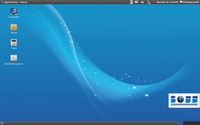Made in India
With BOSS Linux, the Indian Ministry of Communication and Information has developed its own Linux distribution. The system is gradually establishing itself in the local public administration as the successor to Windows XP.

Medialinx AG
With BOSS Linux, the Indian Ministry of Communication and Information has developed its own Linux distribution. The system is gradually establishing itself in the local public administration as the successor to Windows XP.
After much agonizing, Microsoft finally decided to let go of its long outdated Windows XP on April 8, 2014. Although many state agencies in Europe overslept and ended up paying for patches for common vulnerabilities with tax money, those responsible in multicultural India took another route: They parted from Microsoft and migrated to Linux.
India has been committed for some time to a consistent open source strategy. To act on it, the country with its more than 1.2 billion inhabitants has worked with the research and development teams of the Centre for Development of Advanced Computing (C-DAC) and National Resource Centre for Free and Open Source Software (NRCFOSS) to get its own Linux distribution on its feet.
C-DAC provides the Indian Linux with various guises for different purposes. The distribution is supposed to enable a cost-effective modern IT structure on clients and servers for agencies as well as schools. A focal point for the development of Bharat Operating System Solutions (BOSS) [1] Linux is the support for as many local languages as possible to provide citizens access to computing systems in their mother tongue, thus eliminating the entry hurdles into the world of data processing.
[...]